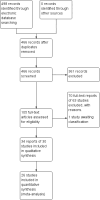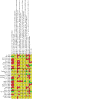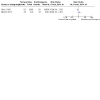Interventions for preventing ophthalmia neonatorum
- PMID: 32959365
- PMCID: PMC8524318
- DOI: 10.1002/14651858.CD001862.pub4
Interventions for preventing ophthalmia neonatorum
Abstract
Background: Ophthalmia neonatorum is an infection of the eyes in newborns that can lead to blindness, particularly if the infection is caused by Neisseria gonorrhoeae. Antiseptic or antibiotic medication is dispensed into the eyes of newborns, or dispensed systemically, soon after delivery to prevent neonatal conjunctivitis and potential vision impairment.
Objectives: 1. To determine if any type of systemic or topical eye medication is better than placebo or no prophylaxis in preventing ophthalmia neonatorum. 2. To determine if any one systemic or topical eye medication is better than any other medication in preventing ophthalmia neonatorum.
Search methods: We searched CENTRAL, MEDLINE, Embase, LILACS, and three trials registers, date of last search 4 October 2019. We also searched references of included studies and contacted pharmaceutical companies. SELECTION CRITERIA: We included randomised and quasi-randomised controlled trials of any topical, systemic, or combination medical interventions used to prevent ophthalmia neonatorum in newborns compared with placebo, no prophylaxis, or with each other.
Data collection and analysis: We used standard methods expected by Cochrane. Outcomes were: blindness or any adverse visual outcome at 12 months, conjunctivitis at 1 month (gonococcal (GC), chlamydial (CC), bacterial (BC), any aetiology (ACAE), or unknown aetiology (CUE)), and adverse effects. MAIN RESULTS: We included 30 trials with a total of 79,198 neonates. Eighteen studies were conducted in high-income settings (the USA, Europe, Israel, Canada), and 12 were conducted in low- and middle-income settings (Africa, Iran, China, Indonesia, Mexico). Fifteen of the 30 studies were quasi-randomised. We judged every study to be at high risk of bias in at least one domain. Ten studies included a comparison arm with no prophylaxis. There were 14 different prophylactic regimens and 12 different medications in the 30 included studies. Any prophylaxis compared to no prophylaxis Unless otherwise indicated, the following evidence comes from studies assessing one or more of the following interventions: tetracycline 1%, erythromycin 0.5%, povidone-iodine 2.5%, silver nitrate 1%. None of the studies reported data on the primary outcomes: blindness or any adverse visual outcome at any time point. There was only very low-certainty evidence on the risk of GC with prophylaxis (4/5340 newborns) compared to no prophylaxis (5/2889) at one month (risk ratio (RR) 0.79, 95% confidence interval (CI) 0.24 to 2.65, 3 studies). Low-certainty evidence suggested there may be little or no difference in effect on CC (RR 0.96, 95% CI 0.57 to 1.61, 4874 newborns, 2 studies) and BC (RR 0.84, 95% CI 0.37 to 1.93, 3685 newborns, 2 studies). Moderate-certainty evidence suggested a probable reduction in risk of ACAE at one month (RR 0.65, 95% 0.54 to 0.78, 9666 newborns, 8 studies assessing tetracycline 1%, erythromycin 0.5%, povidone-iodine 2.5%, silver nitrate 1%, colostrum, bacitracin-phenacaine ointment). There was only very low-certainty evidence on CUE (RR 1.75, 95% CI 0.37 to 8.28, 330 newborns, 1 study). Very low-certainty evidence on adverse effects suggested no increased nasolacrimal duct obstruction (RR 0.93, 95% CI 0.68 to 1.28, 404 newborns, 1 study of erythromycin 0.5% and silver nitrate 1%) and no increased keratitis (single study of 40 newborns assessing silver nitrate 1% with no events). Any prophylaxis compared to another prophylaxis Overall, evidence comparing different interventions did not suggest any consistently superior intervention. However, most of this evidence was of low-certainty and was extremely limited.
Authors' conclusions: There are no data on whether prophylaxis for ophthalmia neonatorum prevents serious outcomes such as blindness or any adverse visual outcome. Moderate-certainty evidence suggests that the use of prophylaxis may lead to a reduction in the incidence of ACAE in newborns but the evidence for effect on GC, CC or BC was less certain. Comparison of individual interventions did not suggest any consistently superior intervention, but data were limited. A trial comparing tetracycline, povidone-iodine (single administration), and chloramphenicol for GC and CC could potentially provide the community with an effective, universally applicable prophylaxis against ophthalmia neonatorum.
Copyright © 2020 The Cochrane Collaboration. Published by John Wiley & Sons, Ltd.
Conflict of interest statement
VK was funded by a three‐month Pharmaceutical Manufacturers' Association of Canada/IWK‐Grace Scholarship for part of the time spent on this systematic review. However, neither Dr Kapoor nor anyone else involved with this review has ever had any financial links with the Pharmaceutical Manufacturers' Association of Canada. JE has no known interests to declare. SSV's earlier effort on this review was supported by the Cochrane Eyes and Vision Group US Project with funding through Contract N‐01‐EY‐2‐1003 with the National Eye Institute, National Institutes of Health, USA. The Cochrane Eyes and Vision Group US Project is now supported by co‐operative agreement 1 U01 EY020522, National Eye Institute, National Institutes of Health, USA.
Figures

































































































Comment in
-
Cochrane corner: interventions for preventing ophthalmia neonatorum.Eye (Lond). 2022 Feb;36(2):356-357. doi: 10.1038/s41433-021-01803-8. Epub 2021 Oct 12. Eye (Lond). 2022. PMID: 34642498 Free PMC article. No abstract available.
References
References to studies included in this review
Ali 2007 {published data only}
-
- Ali Z, Khadije D, Elahe A, Fateme N, Mohammad M, Fateme Z, et al. Prophylaxis of ophthalmia neonatorum comparison of Betadine, erythromycin and no prophylaxis. Journal of Tropical Pediatrics 2007;53(6):388-92. - PubMed
Bell 1993 {published data only}
-
- Bell TA, Grayston JT, Krohn MA, Kronmal RA. Randomized trial of silver nitrate, erythromycin, and no eye prophylaxis for the prevention of conjunctivitis among newborns not at risk for gonococcal ophthalmitis. Eye Prophylaxis Study Group. Pediatrics 1993;92(6):755-60. - PubMed
-
- Krohn MA, Hillier SL, Bell TA, Kronmal RA, Grayston JT. The bacterial etiology of conjunctivitis in early infancy. Eye Prophylaxis Study Group. American Journal of Epidemiology 1993;138(5):326-32. - PubMed
Bramantyo 2016 {published data only}
-
- Bramantyo T, Roeslani RD, Andriansjah A, Sitorus RS. The efficacy of 1% chloramphenicol eye ointment versus 2.5% povidone-iodine ophthalmic solution in reducing bacterial colony in newborn conjunctivae. Asia-Pacific Journal of Ophthalmology 2015;4(3):180-3. - PubMed
Brussieux 1991 {published data only}
-
- Brussieux J, Boisivon A, Theron HP, Faidherbe C, Machado N, Michelon B. Prevention of neonatal conjunctivitis. A comparative clinical and bacteriologic study of 2 eyedrops: silver nitrate and oxytetracycline chlorhydrate [Prevention des conjonctivites neonatales. Etude comparative clinique et bacteriologique de deux collyres: nitrate d' argent et chlorhydrate d' oxytetracycline]. Annales de Pediatrie 1991;38(9):637-41. - PubMed
Chen 1992 {published data only}
-
- Chen JY. Prophylaxis of ophthalmia neonatorum: comparison of silver nitrate, tetracycline, erythromycin and no prophylaxis. Pediatric Infectious Disease Journal 1992;12(12):1026-30. - PubMed
Christian 1960 {published data only}
-
- Christian JR. Comparison of ocular reactions with the use of silver nitrate and erythromycin ointment in ophthalmia neonatorum prophylaxis. Journal of Pediatrics 1960;57(1):55-60. - PubMed
Cousineau 1952 {published data only}
-
- Cousineau GG, Lloyd LA. Preliminary report on prophylaxis of ophthalmia neonatorum. Transactions of the Canadian Ophthalmological Society 1952;5:75-80.
David 2011 {published data only}
-
- David M, Rumelt S, Weintraub Z. Efficacy comparison between povidone iodine 2.5% and tetracycline 1% in prevention of ophthalmia neonatorum. Ophthalmology 2011;118(7):1454-8. - PubMed
Davidson 1951 {published data only}
-
- Davidson HH, Hill JH. Penicillin in the prophylaxis of ophthalmia neonatorum. Journal of the American Medical Association 1951;145(14):1052-5. - PubMed
Fischer 1988 {published data only}
-
- Fischer PR, Reta BB. Prevention of neonatal conjunctivitis in Zaire. Annals of Tropical Paediatrics 1988;8(2):85-6. - PubMed
Ghaemi 2014 {published data only}
Ghahramani 2007 {published data only}
-
- Ghahramani M, Ghahramani AA. Epidemiologic study of ophthalmia neonatorum and impact of prophylaxis on its incidence. Acta Medica Iranica 2007;45(5):361-4.
Ghotbi 2012 {published data only}
-
- Ghotbi N. Comparison of the effect of tetracycline 1% and erythromycin 0.5% ophthalmic ointments for prophylaxis of ophthalmia neonatorum. Scientific Journal of Kurdistan University of Medical Sciences 2012;17(3):20-5.
Graf 1994 {published data only}
-
- Graf H, Retke U, Schilling C, Schmidt M. Reaction of the ophthalmic front region to the Crede-prophylaxis [Die reakton des vorderen augenabschnittes auf die Crede-prophylaxe]. Zentralblatt fur Gynakologie 1994;116(11):639-42. - PubMed
Hammerschlag 1980 {published data only}
-
- Hammerschlag MR, Chandler JW, Alexander ER, English M, Chiang WT, Koutsky L, et al. Erythromycin ointment for ocular prophylaxis of neonatal chlamydial infection. JAMA 1980;244(20):2291-3. - PubMed
Hammerschlag 1989 {published data only}
-
- Hammerschlag MR, Cummings C, Roblin PM, Williams TH, Delke I. Efficacy of neonatal ocular prophylaxis for the prevention of chlamydial and gonococcal conjunctivitis. New England Journal of Medicine 1989;320(12):769-72. - PubMed
Harris 1957 {published data only}
-
- Harris ST. Silver nitrate in ophthalmia neonatorum prophylaxis. Sight Saving Review 1957;27(3):152-3.
Hick 1985 {published data only}
-
- Hick JF, Block DJ, Ilstrup DM. A controlled study of silver nitrate prophylaxis and the incidence of nasolacrimal duct obstruction. Journal of Pediatric Ophthalmology and Strabismus 1985;22(3):92-3. - PubMed
Isenberg 1995 {published data only}
-
- Isenberg SJ, Apt L, Wood M. A controlled trial of povidone-iodine as prophylaxis against ophthalmia neonatorum. New England Journal of Medicine 1995;332(9):562-6. - PubMed
-
- Isenberg SJ, Apt L, Wood M. The influence of perinatal infective factors on ophthalmia neonatorum. Journal of Pediatric Ophthalmology and Strabismus 1996;33(3):185-8. - PubMed
Isenberg 2003 {published data only}
Kaivonen 1965a {published data only}
-
- Kaivonen M. Prophylaxis of ophthalmia neonatorum. A clinical and bacteriologic study of ophthalmia neonatorum and conjunctival bacterial flora of the newborn. Acta Ophthalmologica 1965;79(Suppl):9-70. - PubMed
Kaivonen 1965b {published data only}
-
- Kaivonen M. Prophylaxis of ophthalmia neonatorum. A clinical and bacteriologic study of ophthalmia neonatorum and conjunctival bacterial flora of the newborn. Acta Ophthalmologica 1965;79(Suppl):9-70. - PubMed
Laga 1988 {published data only}
-
- Laga M, Plummer FA, Piot P, Datta P, Namaara W, Ndinya-Achola JO, et al. Prophylaxis of gonococcal and chlamydial ophthalmia neonatorum. A comparison of silver nitrate and tetracycline. New England Journal of Medicine 1988;318(11):653-7. - PubMed
Pastor 2015 {published data only (unpublished sought but not used)}
Posner 1959 {published data only}
-
- Posner AC, Anderson GD, Prigot A. Observations on the prophylaxis of ophthalmia neonatorum in a municipal hospital. In: Antibiotics Annual 1958-59. New York: Medical Encyclopedia Inc, 1958:552-5. - PubMed
Ramirez‐Ortiz 2007 {published data only}
-
- Ramirez-Ortiz MA, Rodriguez-Almaraz M, Ocha-Diaz Lopez H, Diaz-Prieto P, Rodriguez-Suarez RS. Randomised equivalency trial comparing 2.5% povidone-iodine eye drops and ophthalmic chloramphenicol for preventing neonatal conjunctivitis in a trachoma endemic area in southern Mexico. British Journal of Ophthalmology 2007;91(11):1430-4. - PMC - PubMed
Richter 2006 {published data only}
-
- Richter R, Below H, Kadow I, Kramer A, Müller C, Fusch C. Effect of topical 1.25% povidone-iodine eyedrops used for prophylaxis of ophthalmia neonatorum on renal iodine excretion and thyroid-stimulating hormone level. Journal of Pediatrics 2006;148(3):401-3. - PubMed
Siegel 1982 {published data only}
-
- Siegel JD, McCracken GH, Threlkeld N, DePasse BM, Rosenfeld CR. Single dose penicillin prophylaxis in neonatal group-B streptococcal disease. Conclusion of a 41 month controlled trial. Lancet 1982;1(8287):1426-30. - PubMed
-
- Siegel JD, McCracken GH, Threlkeld N, Milvenan B, Rosenfeld CR. Single dose penicillin prophylaxis against neonatal group-B streptococcal infections. New England Journal of Medicine 1980;303(14):769-75. - PubMed
Wahlberg 1982 {published and unpublished data}
-
- Wahlberg V. Crede's prevention method has lost its justification today [Credeprofylax - en metod som idag saknar berattigande]. Nordisk Medicin 1982;97(2):36-7. - PubMed
-
- Wahlberg V. Reconsideration of Crede prophylaxis. A study of maternity and neonatal care. Acta Paediatrica Scandinavica 1982;295(Suppl):1-73. - PubMed
Zbojan 2004 {published data only}
-
- Zbojan J, Dluholucky S, Zacharovska M. Credeization with povidone-iodine - efficiency and a possible influence on thyroid gland in newborns [Kredeizacia povidon-jodidom - ucinnost a mozny vplyv na stitnu zlazu novorodenca]. Cesko Slovenska Pediatrie 2004;59(1):11-3.
References to studies excluded from this review
Assadian 2002 {published data only}
-
- Assadian O, Assadian A, Aspock C, Hahn D, Koller W. Prophylaxis of ophthalmia neonatorum - a nationwide survey of the current practice in Austria. Wiener Klinische Wochenschrift 2002;114(5-6):194-9. - PubMed
Bailey 1993 {published data only}
-
- Bailey RL, Arullendran P, Whittle HC, Mabey DC. Randomised controlled trial of single-dose azithromycin in treatment of trachoma. Lancet 1993;342(8869):453-6. - PubMed
Baptista 1968 {published data only}
-
- Baptista OR. Ophthalmia neonatorum. Prophylaxis with 5-nitro-2-furaldehyde-semicarbazone (Furacin). British Journal of Venereal Diseases 1968;44(2):189.
-
- Baptista OR. Ophthalmia neonatorum. Prophylaxis with 5-nitro-2-furaldehyde-semicarbazone [Oftalmia neonatorum. Prevencao com 5 nitro 2 furaldeido semicarbazona (Furacin)]. Hospital 1967;71(1):187-93. - PubMed
Baveja 1997 {published data only}
-
- Baveja UK, Hiranandani MK, Talwar P, Sen DK. Laboratory techniques for diagnosis of chlamydial infections of the eye. Journal of Communicable Diseases 1997;29(3):247-53. - PubMed
Bobo 1997 {published data only}
-
- Bobo LD, Novak N, Munoz B, Hsieh YH, Quinn TC, West S. Severe disease in children with trachoma is associated with persistent Chlamydia trachomatis infection. Journal of Infectious Disease 1997;176(6):1524-30. - PubMed
Brady 1997 {published data only}
-
- Brady RC. Index of suspicion. Case 2. Diagnosis: gonorrhea conjunctivitis. Pediatrics in Review 1997;18(5):175-7. - PubMed
Burr 2017 {published data only}
Candano 1951 {published data only}
-
- Candano A, Avila Cisneros I. Prophylaxis against ophthalmia neonatorum. Penicillin as a substitute for Crede's method [Profilaxis de la oftalmia neonatorum. Utilizacion de la penicilina en substitucion del metodo Crede]. Boletin de la Sociedad Medica Del Centro, Materno Infantil General Maximino Avila Camacho 1950;1:57-61.
-
- Candano A, Avila Cisneros I. Prophylaxis against ophthalmia neonatorum. Penicillin as a substitute for Crede's method. British Journal of Venereal Diseases 1951;27(3):167.
CDC 1998 {published data only}
-
- Centers for Disease Control and Prevention (CDC). Acute Hemorrhagic Conjunctivitis -- St. Croix, U.S. Virgin Islands, September-October 1998. Morbidity and Mortality Weekly Report (MMWR) 1998;47(42):899-901. - PubMed
Clark 1951 {published data only}
-
- Clark SG, Culler AM. Aureomycin as prophylaxis against ophthalmia neonatorum. American Journal of Ophthalmology 1951;34:840-7. - PubMed
-
- Clark SG, Culler AM. Aureomycin as prophylaxis against ophthalmia neonatorum. British Journal of Venereal Diseases 1951;27(4):209.
Cohen 1990 {published data only}
-
- Cohen R, la Rocque F, Bouhanna A, Boucherat M, Elbez A, Lecompte MD, et al. Randomized study of cefatrizine versus cefaclor in conjunctivitis otitis syndrome [Etude randomisee cefatrizine versus cefaclor dans le syndrome otite-conjonctivite]. Pathologie Biologie Paris 1990;38(5 Part 2):517-20. - PubMed
Darling 2010 {published data only}
-
- Darling EK, McDonald H. A meta-analysis of the efficacy of ocular prophylactic agents used for the prevention of gonococcal and chlamydial ophthalmia neonatorum. Journal of Midwifery and Women's Health 2010;55(4):319-27. - PubMed
Darougar 1977 {published data only}
Dhir 1967 {published data only}
-
- Dhir SP, Agarwal LP, Detels R, Wang SP, Grayston JT. Field trial of two bivalent trachoma vaccines in children of Punjab Indian villages. American Journal of Ophthalmology 1967;63(5 Suppl):1639-44. - PubMed
Drago 1998 {published data only}
-
- Drago F, La-Manna C, Marino V, Marino A, Emmi I, Reibaldi A. Norfloxacin exhibits negligible serum concentrations after repeated conjunctival instillation in children. British Journal of Clinical Pharmacology 1998;46(3):272-4. - PubMed
Fok 1995 {published data only}
-
- Fok TF, Wong W, Cheng AF. Use of eyepatches in phototherapy: effects on conjunctival bacterial pathogens and conjunctivitis. Pediatric Infectious Disease Journal 1995;14(12):1091-4. - PubMed
Fransen 1984 {published data only}
-
- Fransen L, Nsanze H, D'Costa L, Brunham RC, Ronald AR, Piot P. Single-dose kanamycin therapy of gonococcal ophthalmia neonatorum. Lancet 1984;2(8414):1234-7. - PubMed
Gross 1997 {published data only}
-
- Gross RD, Hoffman RO, Lindsay RN. A comparison of ciprofloxacin and tobramycin in bacterial conjunctivitis in children. Clinical Pediatrics 1997;36(8):435-44. - PubMed
Hammerschlag 1997 {published data only}
-
- Hammerschlag MR, Roblin PM, Gelling M, Tsumura N, Jule JE, Kutlin A. Use of polymerase chain reaction for the detection of Chlamydia trachomatis in ocular and nasopharyngeal specimens from infants with conjunctivitis. Pediatric Infectious Disease Journal 1997;16(3):293-7. - PubMed
Hammerschlag 1998 {published data only}
-
- Hammerschlag MR, Gelling M, Roblin PM, Kutlin A, Jule JE. Treatment of neonatal chlamydial conjunctivitis with azithromycin. Pediatric Infectious Disease Journal 1998;17(11):1049-50. - PubMed
Heggie 1985 {published data only}
-
- Heggie AD, Jaffe AC, Stuart LA, Thombre PS, Sorensen RU. Topical sulfacetamide vs oral erythromycin for neonatal chlamydial conjunctivitis. American Journal of Diseases of Children 1985;139(6):564-6. - PubMed
Horven 1993 {published data only}
-
- Horven I. Acute conjunctivitis. A comparison of fusidic acid viscous eye drops and chloramphenicol. Acta Ophthalmologica 1993;71(2):165-8. - PubMed
Iroha 1998 {published data only}
-
- Iroha EO, Kesah CN, Egri-Okwaji MT, Odugbemi TO. Bacterial eye infection in neonates, a prospective study in a neonatal unit. West African Journal of Medicine 1998;17(3):168-72. - PubMed
Isenberg 1994 {published data only}
-
- Isenberg SJ, Apt L, Yoshimori R, Leake RD, Rich R. Povidone-iodine for ophthalmia neonatorum prophylaxis. American Journal of Ophthalmology 1994;118(6):701-6. - PubMed
Jacobson 1988 {published data only}
Keenan 2010 {published data only}
-
- Keenan JD, Eckert S, Rutar T. Cost analysis of povidone-iodine for ophthalmia neonatorum prophylaxis. Archives of Ophthalmology 2010;128(1):136-7. - PubMed
Khan 2016 {published data only}
-
- Khan FA, Hussain MA, Niazi SPK, Haq ZU, Akhtar N. Efficacy of 2.5% and 1.25% povidone-iodine solution for prophylaxis of ophthalmia neonatorum. Journal of the College of Physicians and Surgeons Pakistan 2016;26(2):121-4. - PubMed
Klein 1997 {published data only}
-
- Klein JO. History of macrolide use in pediatrics. Pediatric Infectious Disease Journal 1997;16(4):427-31. - PubMed
Kramer 1997 {published data only}
-
- Kramer A, Behrens-Baumann W. Prophylactic use of topical anti-infectives in ophthalmology. Ophthalmologica 1997;211(Suppl 1):68-76. - PubMed
Laga 1986 {published data only}
-
- Laga M, Naamara W, Brunham RC, D'Costa LJ, Nsanze H, Piot P, et al. Single dose therapy of gonococcal ophthalmia neonatorum with ceftriaxone. New England Journal of Medicine 1986;315(22):1382-5. - PubMed
Lietman 1998 {published data only}
-
- Lietman T, Dawson C, Osaki S. Ocular chlamydial infections. International Ophthalmology Clinics 1998;38(4):125-35. - PubMed
Maharajan 1997 {published data only}
-
- Maharajan S, Thomas R, Kuriakose T. Conjunctivitis and red eye. National Medical Journal of India 1997;10(3):130-3. - PubMed
Mani 1997 {published data only}
-
- Mani VR, Vidya KC. A microbiological study of ophthalmia neonatorum in hospital-born babies. Journal of the Indian Medical Association 1997;95(7):416-7. - PubMed
Mann 1954 {published data only}
Margileth 1957 {published data only}
-
- Margileth AM. Comparison of ocular reaction using penicillin and bacitracin ointments in ophthalmia neonatorum prophylaxis. British Journal of Venereal Diseases 1958;34(3):266. - PubMed
-
- Margileth AM. Comparison of ocular reaction using penicillin and bacitracin ointments in ophthalmia neonatorum prophylaxis. Journal of Pediatrics 1957;51:646-51. - PubMed
Markham 1994 {published data only}
-
- Markham A, Faulds D. Roxithromycin. An update of its antimicrobial activity, pharmacokinetic properties and therapeutic use. Drugs 1994;48(2):297-326. - PubMed
McAuley 1994 {published data only}
-
- McAuley J, Boyer KM, Patel D, Mets M, Swisher C, Roizen N, et al. Early and longitudinal evaluations of treated infants and children and untreated historical patients with congenital toxoplasmosis: the Chicago Collaborative Treatment Trial. Clinical Infectious Diseases 1994;18(1):38-72. - PubMed
Mets 1997 {published data only}
-
- Mets MB, Holfels E, Boyer KM, Swisher CN, Roizen N, Stein L, et al. Eye manifestations of congenital toxoplasmosis. American Journal of Ophthalmology 1997;123(1):1-16. - PubMed
Meyer 1997 {published data only}
-
- Meyer D. Ophthalmia neonatorum prophylaxis - can we do it more cost-effectively. South African Medical Journal 1997;87(4):76-7. - PubMed
Nakagawa 1997 {published data only}
-
- Nakagawa H. Treatment of chlamydial conjunctivitis. Ophthalmologica 1997;211(Suppl 1):25-8. - PubMed
Nichols 1966 {published data only}
-
- Nichols RL, Bell SD Jr, Murray ES, Haddad NA, Bobb AA. Studies on trachoma. V. Clinical observations in a field trial of bivalent trachoma vaccine at three dosage levels in Saudi Arabia. American Journal of Tropical Medicine and Hygiene 1966;15(4):639-47. - PubMed
Normann 2002 {published data only}
-
- Normann EK, Bakken O, Peltola J, Andreasson B, Buhl S, Sigg P, et al. Treatment of acute neonatal bacterial conjunctivitis: a comparison of fucidic acid to chloramphenicol drops. Acta Ophthalmologica Scandinavica 2002;80(2):183-7. - PubMed
Peters 1992 {published data only}
-
- Peters DH, Clissold SP. Clarithromycin. A review of its antimicrobial activity, pharmacokinetic properties and therapeutic potential. Drugs 1992;44(1):117-64. - PubMed
Ratelle 1997 {published data only}
-
- Ratelle S, Keno D, Hardwood M, Etkind PH. Neonatal chlamydial infections in Massachusetts, 1992-1993. American Journal of Preventive Medicine 1997;13(3):221-4. - PubMed
Reimer 1997 {published data only}
-
- Reimer K, Fleischer W, Brogmann B, Schreier H, Burkhard P, Lanzendorfer A, et al. Povidone-iodine liposomes - an overview. Dermatology 1997;1995(Suppl 2):93-9. - PubMed
Rivlin 1997 {published data only}
-
- Rivlin ME, Morrison JC, Grossman JH 3rd. Comparison of pregnancy outcome between treated and untreated women with chlamydial cervicitis. Journal of the Mississippi State Medical Association 1997;38(11):404-7. - PubMed
Rosenman 2003 {published data only}
-
- Rosenman MB, Mohan BE, Downs SM, Kleiman MB. Oral erythromycin prophylaxis vs watchful waiting in caring for newborns exposed to Chlamydia trachomatis. Archives of Pediatrics and Adolescent Medicine 2003;157(6):565-71. - PubMed
Schaller 1997 {published data only}
-
- Schaller U, Mino de Kaspar H, Schriever S, Klauss V. Ophthalmia neonatorum caused by Chlamydia trachomatis. Rapid diagnosis and therapy [Ophthalmia neonatorum durch Chlamydia trachomatis. Schnelldiagnostik und therapie]. Ophthalmologe 1997;94(5):317-20. - PubMed
Seiga 1993 {published data only}
-
- Seiga K, Shoji T. Chemoprophylaxis of ophthalmia neonatorum through vertical infection. Evaluation of Crede's method using norfloxacin and gentamicin. Japanese Journal of Antibiotics 1993;4(4):331-6. - PubMed
Silva 2008 {published data only}
-
- Silva LR, Gurgel RQ, Ribeiro D, Lima R, Cuevas LE. Current usefulness of Crede's method of preventing neonatal ophthalmia. Annals of Tropical Paediatrics 2008;28(1):45-8. - PubMed
Sorsby 1949 {published data only}
Stenberg 1991 {published data only}
-
- Stenberg K, Mardh PA. Treatment of chlamydial conjunctivitis in newborns and adults with erythromycin and roxithromycin. Journal of Antimicrobial Chemotherapy 1991;28(2):301-7. - PubMed
Sud 1995 {published data only}
-
- Sud RN, Greval RS, Bajwa RS. Topical flurbiprofen therapy in vernal keratoconjunctivitis. Indian Journal of Medical Sciences 1995;49(9):205-9. - PubMed
Sung 1998 {published data only}
-
- Sung L, MacDonald NE. Gonorrhea: a pediatric perspective. Pediatrics in Review 1998;19(1):13-6. - PubMed
van Bogaert 1997 {published data only}
-
- Bogaert LJ. Controversies in the approach to ophthalmia neonatorum. South African Medical Journal 1997;87(1):76-7. - PubMed
Wallace 1998 {published data only}
-
- Wallace DK, Steinkuller PG. Ocular medications in children. Clinical Pediatrics 1998;37(11):645-52. - PubMed
West 1995 {published data only}
-
- West S, Munoz B, Lynch M, Kayongoya A, Chilangwa Z, Mmbaga BB, et al. Impact of face washing on trachoma in Kongwa, Tanzania. Lancet 1995;345(8943):155-8. - PubMed
Winceslaus 1987 {published data only}
Woolridge 1967 {published data only}
-
- Woolridge RL, Grayston JT, Chang IH, Yang CY, Cheng KH. Long-term follow-up of the initial (1959-1960) trachoma vaccine field trial on Taiwan. American Journal of Ophthalmology 1967;63(Suppl 5):1650-5. - PubMed
Wu 2003 {published data only}
-
- Wu SX, Yang J, Liu G. A clinical study in China of neonatal conjunctivitis caused by Chlamydia trachomatis. Clinical Pediatrics 2003;42(1):83-4. - PubMed
Yasunaga 1977 {published data only}
-
- Yasunaga S, Kean E. Effect of three ophthalmic solutions on chemical conjunctivitis in the neonate. Obstetrical and Gynecological Survey 1977;32(7):593-4. - PubMed
-
- Yasunaga S, Kean EH. Effect of three ophthalmic solutions on chemical conjunctivitis in the neonate. American Journal of Diseases of Children 1977;131(2):159-61. - PubMed
Yetman 1997 {published data only}
-
- Yetman RJ, Coody DK. Conjunctivitis: a practice guideline. Journal of Pediatric Health Care 1997;11(5):238-41. - PubMed
Zanoni 1992 {published data only}
-
- Zanoni D, Isenberg SJ, Apt L. A comparison of silver nitrate with erythromycin for prophylaxis against ophthalmia neonatorum. Clinical Pediatrics 1992;5(5):295-8. - PubMed
References to studies awaiting assessment
Matinzadeh 2007 {published data only}
-
- Matinzadeh ZK, Beiragdar F, Kavemanesh Z, Abolgasemi H, Amirsalari S. Efficacy of topical ophthalmic prophylaxis in prevention of ophthalmia neonatorum. Tropical Doctor 2007;37(1):47-9. - PubMed
Additional references
Adachi 2016
AFSSAPS 2010
-
- Agence Française de Sécurité Sanitaire. Prophylaxis of conjunctival infections of newborn children [Prophylaxie des infections conjonctivales du nouveau-né]. ansm.sante.fr/var/ansm_site/storage/original/application/8d7b81471c08832... (accessed 23 March 2016).
Albert 1994
-
- Albert DM, Jakobiec FA (editors). Principles and Practice of Ophthalmology: Clinical Practice. Philadelphia: W.B. Saunders Company, 1994.
Amini 2008
-
- Amini E, Ghasemi M, Daneshjou K. A five-year study in Iran of ophthalmia neonatorum: prevalence and etiology. Medical Science Monitor 2008;14(2):90-6. - PubMed
Anonymous 1918
Anonymous 1919
Barsam 1966
-
- Barsam PC. Specific prophylaxis of gonorrheal ophthalmia neonatorum. A review. New England Journal of Medicine 1966;274(13):731-4. - PubMed
Bastion 2006
-
- Bastion ML, Prakash K, Siow YC, Loh SS. Bilateral corneal perforation in a sexually active adult male with gonococcal conjunctivitis. Medical Journal of Malaysia 2006;61(3):366-8. - PubMed
Blatt 2012
-
- Blatt AJ, Lieberman JM, Hoover DR, Kaufman HW. Chlamydial and gonococcal testing during pregnancy in the United States. American Journal of Obstetrics and Gynecology 2012;207(1):55.e1-8. - PubMed
Buller 1900
-
- Buller F. Gonorrhoea in its relation to diseases of the eye. Montreal Medical Journal 1900;29(3):185-7.
Caligaris 2010
-
- Caligaris LS, Medina NH, Durkin SR, Haro-Munoz E, Chinen NH. Assessment of the current ocular health practices within neonatal units in the City of São Paulo, Brazil. Ophthalmic Epidemiology 2010;17(5):333-7. - PubMed
Chang 2006
-
- Chang K, Cheng VY, Kwong NS. Neonatal haemorrhagic conjunctivitis: a specific sign of chlamydial infection. Hong Kong Medical Journal 2006;12(1):27-32. - PubMed
Chhabra 2008
-
- Chhabra MS, Motley WW, Mortensen JE. Eikenella corrodens as a causative agent for neonatal conjunctivitis. Journal of AAPOS 2008;12(5):524-5. - PubMed
Chico 2012
-
- Chico RM, Mayaud P, Ariti C, Mabey D, Ronsmans C, Chandramohan D. Prevalence of malaria and sexually transmitted and reproductive tract infections in pregnancy in sub-Saharan Africa: a systematic review. JAMA 2012;307(19):2079-86. - PubMed
CPS 2002
Crede 1881
-
- Crede CS. Ophthalmia neonatorum in newborn children [Die verhürtung der augenentzündung der neugeborenen]. Archiv fur Gynaekologie 1881;17:50-3.
Crede 1884
-
- Crede CSF. Die Verhütung der Augenentzündung der Neugeborenen (Ophthalmoblennorrhoea neonatorum) der häufigsten und wichtigsten Ursache der Blindheit. Berlin: Hirschwald, 1884.
Dageville 2015
-
- Dageville C. Is prophylaxis against ophthalmia neonatorum justified in French maternity wards? Archives of Pediatrics 2015;22(2):128-9. - PubMed
Darville 2015
-
- Darville T. Chlamydia trachomatis infections in neonates and young children. Seminars in Pediatric Infectious Diseases 2005;16(4):235-44. - PubMed
Davey 2016
Department of Health, UK 2010
-
- Department of Health. Explanatory memorandum to the health protection (part 2a orders) regulations, 2010. No. 658. www.legislation.gov.uk/uksi/2010/658/pdfs/uksiem_20100658_en.pdf (accessed 25 November 2013).
Dharmasena 2015
-
- Dharmasena A, Hall N, Goldacre R, Goldacre MJ. Time trends in ophthalmia neonatorum and dacryocystitis of the newborn in England, 2000-2011: database study. Sexually Transmitted Infections 2015;91(5):342-5. - PubMed
Di Bartolomeo 2001
-
- Di Bartolomeo S, Mirta DH, Janer M, Rodríguez Fermepin MR, Sauka D, Magariños F, et al. Incidence of Chlamydia trachomatis and other potential pathogens in neonatal conjunctivitis. International Journal of Infectious Diseases 2015;5(3):139-43. - PubMed
Di Bartolomeo 2005
-
- Di Bartolomeo S, Higa M, Janer M, Pennisi A, Balbin G, Priore G. Neonatal conjunctivitis in a hospital at Gran Buenos Aires. Last 5 years update. Revista Argentina de Microbiologia 2005;37(3):139-41. - PubMed
Donham 2008
-
- Donham BP, Gibler WB. Images in emergency medicine. Gonococcal conjunctivitis. Annals of Emergency Medicine 2008;52(1):11. - PubMed
Duke‐Elder 1965
-
- Duke-Elder S. Diseases of the outer eye. In: System of Ophthalmology. Vol. 8 (Part 1). St Louis: CV Mosby Co, 1965:167-74.
Dunn 2000
Eser 2009
-
- Eser I, Bozaci M. A nationwide survey of prophylaxis against ophthalmia neonatorum in Turkey. Turkish Journal of Medical Sciences 2009;39(5):771-4.
Foster 1987
Foster 1991
-
- Foster A, Gilbert C. Community efforts in the reduction of corneal blindness in developing countries. Refractive and Corneal Surgery 1991;7(6):445-8. - PubMed
Foster 1995
-
- Foster A, Volker K. Ophthalmia neonatorum in developing countries. New England Journal of Medicine 1995;332(9):600-1. - PubMed
Fransen 1987
-
- Fransen L, den Berghe P, Mertens A. Incidence and bacterial aetiology of neonatal conjunctivitis. European Journal of Pediatrics 1987;146(2):152-5. - PubMed
Gilbert 2012
-
- Gilbert C, Rahi J. Visual impairment and blindness in children – magnitude and causes. In: Johnson G, Minassian D, Weale W, West S, editors(s). Epidemiology of Eye Disease. London: Imperial College Press, 2012.
Glanville 2006
Grzybowski 2018
-
- Grzybowski A, Kanclerz P, Myers WG. The use of povidone-iodine in ophthalmology. Current Opinion in Ophthalmology 2018;29(1):19-32. - PubMed
Guala 2005
Guirguis‐Blake 2019
Hammerschlag 1993
-
- Hammerschlag MR. Neonatal conjunctivitis. Pediatric Annals 1993;22(6):346-51. - PubMed
Haussman 1895
-
- Haussman. Hygiene and public health. Ophthalmia neonatorum. Canadian Practitioner Journal 1895;20:697.
Higgins 2017
-
- Higgins JPT, Altman DG, Sterne JAC (editors). Chapter 8: Assessing risk of bias in included studies. In: Higgins JPT, Churchill R, Chandler J, Cumpston MS (editors), Cochrane Handbook for Systematic Reviews of Interventions version 5.2.0 (updated June 2017). The Cochrane Collaboration, 2017. Available from www.training.cochrane.org/handbook.
Isenberg 1994a
-
- Isenberg SJ (editor). The Eye in Infancy. 2nd edition. St Louis: Mosby, 1994.
Isenberg 1994b
-
- Isenberg SJ, Apt L, Yoshimori R, Leake R, Rich R. Povidone-iodine for ophthalmia neonatorum prophylaxis. American Journal of Ophthalmology 1994;118(6):701-6. - PubMed
Ison 1998
-
- Ison A, Dillon JR, Tapsall JW. The epidemiology of global antibiotic resistance among Neisseria gonorrhoeae and Haemophilus ducreyi. Lancet 1998;351(Suppl):SM8-11. - PubMed
Jug Došler 2015
Kawashima 2009
-
- Kawashima M, Kawakita T, Den S, Tomita M, Shimazaki J. Surgical management of corneal perforation secondary to gonococcal keratoconjunctivitis. Eye 2009;23(2):339-44. - PubMed
Kello 2003
Koay 2015
-
- Koay CL, Patel DK, Tajunisah I, Subrayan V, Lansingh VC. A comparative analysis of avoidable causes of childhood blindness in Malaysia with low income, middle income and high income countries. International Ophthalmology 2015;35(2):201-7. - PubMed
Konigstein 1882
-
- Konigstein L. For the prophylaxis of blenorrhea neonatorum [Zur Prophylaxe der blenorrhea neonatorum]. Arch Kinderheik 1882;2:341-69.
Kramer 2002
-
- Kramer A, Behrens-Baumann W (editors). Antiseptic Prophylaxis and Therapy in Ocular Infections. Vol. 33. Developments in Ophthalmology. Basel: Karger, 2000.
Krohn 1993
-
- Krohn MA, Hillier SL, Bell TA, Kronmal RA, Grayston JT. The bacterial etiology of conjunctivitis in early infancy. American Journal of Epidemiology 1993;138(5):326-32. - PubMed
Laga 1989
Langendam 2013
Lewis 2014
-
- Lewis DA. Global resistance of Neisseria gonorrhoeae: when theory becomes reality. Current Opinion in Infectious Disease 2014;27(1):62-7. - PubMed
Luna 2009
-
- Luna MS, Alonso CR, Mussons FB, Urcelay IE, Conde JR, Narbona E, et al. Recommendations for the care of the healthy normal newborn at delivery and during the first postnatal hours. Anales de Pediatria 2009;71(4):349-61. - PubMed
Martin 2015
McElnea 2015
-
- McElnea E, Stapleton P, Khan S, Stokes J, Higgins G. Challenges in the management of Neisseria gonorrhoeae keratitis. International Ophthalmology 2015;35(1):135-40. - PubMed
Milot 2008
-
- Milot J. Ophthalmia neonatorum of the newborn and its treatments in Canadian medical publications: 1872-1985. Canadian Bulletin of Medical History 2008;25(2):499-514. - PubMed
Mohile 2002
-
- Mohile M, Deorari AK, Satpathy G, Sharma A, Singh M. Microbiological study of neonatal conjunctivitis with special reference to Chlamydia trachomatis. Indian Journal of Ophthalmology 2002;50(4):295-9. - PubMed
Moore 2015
Muhe 1986
Muhit 2007
Mulholland 2015
-
- Mulholland C, Gardiner J. Ophthalmia neonatorum prophylaxis. Canadian Journal of Ophthalmology 2015;50(4):328-9. - PubMed
Mullick 2005
Napchan 2005
-
- Napchan BM, Morales RP, Carvalho ML, Cunha KV, Figueras A. From suspicion to action: the chemical conjunctivitis and silver nitrate connexion example in Brazilian hospitals. Pharmacoepidemiology and Drug Safety 2005;14(8):555-9. - PubMed
Newman 2015
Oriel 1991
Pande 2006
-
- Pande H. When the custom goes blind - 25 years without Credé's prophylaxis [Når sedvane gjør blind – 25 år uten Credés lapisprofylakse]. Tidsskr Nor Lægeforen 2006;8(126):1087-90.
Poliquin 2015
-
- Poliquin V, Wylie J, Cole R, Yudin MH, Van Caesseele P. Preparedness for implementing change in neonatal ocular prophylaxis policies. Journal of Obstetrics and Gynaecology Canada 2016;38(1):7-8. - PubMed
Quirke 2008
-
- Quirke M, Cullinane A. Recent trends in chlamydial and gonococcal conjunctivitis among neonates and adults in an Irish hospital. International Journal of Infectious Diseases 2008;12(4):371-3. - PubMed
R Core Team 2013 [Computer program]
-
- R: A language and environment for statistical computing. R Core Team. Vienna, Austria: R Foundation for Statistical Computing, 2013. www.R-project.org.
Rahi 1995
-
- Rahi JS, Sripathi S, Gilbert CE, Foster A. Childhood blindness in India: causes in 1318 blind school students in nine states. Eye 1995;9(5):545-50. - PubMed
Robaei 2014
-
- Robaei D, Watson S. Corneal blindness: a global problem. Clinical and Experimental Ophthalmology 2014;42(3):213-4. - PubMed
Rours 2008
-
- Rours IG, Hammerschlag MR, Ott A, De Faber TJ, Verbrugh HA, Groot R, et al. Chlamydia trachomatis as a cause of neonatal conjunctivitis in Dutch infants. Pediatrics 2008;121(2):e321-6. - PubMed
Sandström 1984
-
- Sandström KI, Bell TA, Chandler JW, Kuo CC, Wang SP, Grayston JT, et al. Microbial causes of neonatal conjunctivitis. Journal of Pediatrics 1984;105(5):706-11. - PubMed
Sandström 1987
-
- Sandström I. Etiology and diagnosis of neonatal conjunctivitis. Acta Paediatrica Scandinavica 1967;76(2):221-7. - PubMed
Schwab 1985
Shaw 1977
-
- Shaw EB. Questions need for prophylaxis with silver nitrate. Pediatrics 1977;59(5):792. - PubMed
Sweeting 2004
-
- Sweeting MJ, Sutton AJ, Lambert PC. What to add to nothing? Use and avoidance of continuity corrections in meta-analysis of sparse data. Statistics in Medicine 2004;23(9):1351-75. - PubMed
Totten 2015a
Totten 2015b
Tribolet 2016
-
- Tribolet S, Gillard P, Lefèvre A, Rigo V. Gonococcal ophthalmia neonatorum: clinical illustration, prevention, and future prospects. Archives of Pediatrics 2016;23(3):297-300. - PubMed
Unemo 2016
UNICEF
-
- UNICEF. Antenatal care. data.unicef.org/maternal-health/antenatal-care.html (accessed 13 December 2019).
USPSTF 2011
-
- US Preventive Services Task Force (USPSTF). Ocular prophylaxis for gonococcal ophthalmia neonatorum: U.S. Preventive Services Task Force reaffirmation recommendation statement. Agency for Healthcare Research and Quality 2011. - PubMed
USPSTF 2019
-
- US Preventive Services Task Force. Ocular Prophylaxis for Gonococcal Ophthalmia Neonatorum: US Preventive Services Task Force Reaffirmation Recommendation Statement. JAMA 2019;321(4):394-8. - PubMed
Van de Laar 2012
-
- Van de Laar M, Spiteri G. Increasing trends of gonorrhoea and syphilis and the threat of drug-resistant gonorrhoea in Europe. European Surveillance 2012;17(29):202-25. - PubMed
Vedantham 2004
Verma 1994
-
- Verma M, Chhatwal J, Varughese PV. Neonatal conjunctivitis: a profile. Indian Pediatrics 1994;31(11):1357-61. - PubMed
Volksgezondheid 1980
-
- Volksgezondheid (Leidschendam) Geneeskundige Hoofdinspectie van de. Methode van Crede, ja of nee?: staatstoezicht op de volksgezondheid. Geneeskundigen Hoofdinspectie van de Volksgezondheid, 1980.
Wan 1986
-
- Wan WL, Farkas GC, May WN. The clinical characteristics and course of adult gonococcal conjunctivitis. American Journal of Ophthalmology 1986;102(5):575-83. - PubMed
WESP2016
-
- United Nations. World economic situation and prospects. www.un.org/en/development/desa/policy/wesp/wesp_current/2016wesp_full_en... (accessed 10 April 2019).
Whitcher 2001
WHO 1986
-
- World Health Organization. Conjunctivitis of the newborn: prevention and treatment at the primary health care level. apps.who.int/iris/bitstream/10665/39482/1/9241560886_eng.pdf (accessed 23 March 2016).
WHO 1999
-
- World Health Organization. What is VISION 2020? www.who.int/blindness/partnerships/vision2020/en/ (accessed 24 March 2016).
WHO 2012
-
- World Health Organization. Baseline report on global sexually transmitted infection surveillance. apps.who.int/iris/bitstream/10665/85376/1/9789241505895_eng.pdf (accessed 24 March 2016).
WHO 2013
-
- World Health Organization. Universal eye health: a global action plan 2014–2019. www.who.int/blindness/actionplan/en/ (accessed 23 March 2016).
WHO 2015
-
- WHO, UN Population Fund, UNICEF. Integrated Management of Pregnancy and Childbirth. Pregnancy, Childbirth, Postpartum and Newborn Care: a Guide for Essential Practice. 3rd edition. Geneva: WHO, 2015. - PubMed
WHO 2017
-
- World Health Organization. WHO recommendations on newborn health: guidelines approved by the WHO Guidelines Review Committee. Vol. WHO/MCA/17.07. Geneva: World Health Organization, 2017. [CC BY-NC-SA 3.0 IGO]
Yip 2008
-
- Yip PP, Chan WH, Yip KT, Que TL, Kwong NS, Ho CK. The use of polymerase chain reaction assay versus conventional methods in detecting neonatal chlamydial conjunctivitis. Journal of Pedatric Ophthalmology and Strabismus 2008;45(4):234-9. - PubMed
Zloto 2016
-
- Zloto O, Gharaibeh A, Mezer E, Stankovic B, Isenberg S, Wygnanski-Jaffe T. Ophthalmia neonatorum treatment and prophylaxis: IPOSC global study. Graefe's Archive for Clinical and Experimental Ophthalmology 2016;254(3):577-82. - PubMed
Publication types
MeSH terms
Substances
Grants and funding
LinkOut - more resources
Full Text Sources
Miscellaneous

